
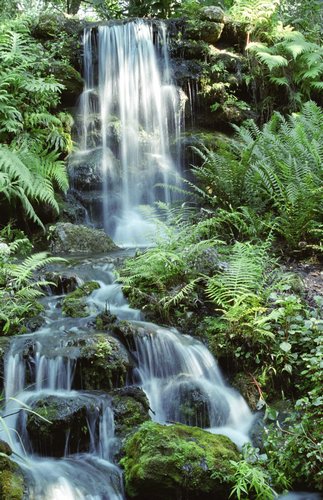
|
|
Photo by Jarrett Baker.
|
Whether you are interested in the water fowl of Canaveral National Seashore or the lush ferns and waterfalls of Devil’s Millhopper State Park, the real Florida can often be found a short distance from city life.
Planning a photography road trip is not time consuming. In a few short hours, Tim Scott, his son Clint and I mapped out a route that crisscrossed the state. We hoped to photograph a large amount of wildlife and capture the essence of Florida’s spirit - away from the tourist traps and busy city life.
Our trip began at 4:00 a.m. on June 2nd. It was a very early morning, but we wanted to have a full day exploring Rainbow Springs State Park in Dunnellon. To our dismay, a torrential rain flooded the park’s campground shortly after we finished setting up camp.
After the rain subsided we donned SCUBA and snorkel gear to explore the Rainbow River. “The river’s not as clear as I hoped it would be,” Tim commented. We meandered up river towards the head springs from the campground photographing any aquatic life we saw.
At one point, several small bait fish were biting at the lens of Tim’s underwater housing for his digital camera. The sky was overcast, and rain runoff probably added to the decreased visibility. On a sunny day the trip up river would offer unique views not seen above water.
Diving is not permitted in the head springs area. However, a swimming area is roped off and we saw many people enjoying the seventy-seven degree water.
Nearly 450 million gallons of water flow down the 5.6 mile Rainbow River from the springs each day. The river merges with the Withlacoochee River and eventually flows to the Gulf of Mexico.
The park was originally opened as Blue Springs. However, the name was changed to Rainbow Springs in the 1930s to distinguish the attraction from other Blue Springs around the state. In 1995 the springs reopened as a state park after being abandoned since the 1970s. The man made waterfalls built while the springs were a private attraction survived the 20 year closure. While not a feature often seen in Florida, the falls were beautiful and the photographs I took of them turned out very well.
A two mile nature trail meanders away from the hills and waterfalls near the springs. The trail runs through an old cattle field and the mid-afternoon sun drained our energy. Every so often, Clint, Tim and I began swatting at deer flies that were persistently sampling our sweat-soaked skin.
“This is a deer fly death march!” Clint exclaimed. On Thursday morning we traveled to Cedar Key Museum State Park. The park features salt evaporators from the Civil War era, several large cannons and the house of St. Clair Whitman; which features a large collection of sea shells and other Florida artifacts.
Other than exterior shots of the house and iron relics, we did not find much to photograph at the park. Many of the houses in Cedar Key are built on stilts, presumably to escape the storm surge of a hurricane.
They looked strange to Clint and I, who are used to houses built directly on foundations. The houses that weren’t on stilts were painted a variety of colors. Some were painted very extravagantly; the finished coat looked a lot like bare concrete block.
We backtracked on State Road 24, across U.S. 19 and through Otter Creek to Gainesville after leaving Cedar Key.
Our timing could not have been more perfect. We arrived shortly after 11:00 a.m., just after Sonny’s Bar-be-que opened its doors for lunch time business.
We stuffed our bellies for an hour, and then waited out the rain at the Florida Museum of Natural History at the University of Florida.
The museum has a large collection of Indian artifacts and an exhibit time lining Florida’s geological history. One can spend countless hours in the museum studying the unique past of the Sunshine State. When the rain stopped we traveled to Devil’s Millhopper on the northeast side of Gainesville.
Devil’s Millhopper Geological State Park is located on the northwest side of Gainesville. The park is a giant sink hole that geologists believe formed 10,000 - 14,000 years ago.
“The satanic connection probably comes from the fact that the water flows into the bowels of the earth,” an information plaque in the park stated. “Millions of fossils were once strewn on the bottom _ perhaps suggesting the remains of the sinister character’s victims.” The sinkhole forms the shape of a mill’s hopper, which were commonly used in the 1800’s when the sinkhole acquired its name.
Two hundred thirty-six steps lead visitors to the bottom of the 120-feet deep hole. Water from Deer Run, a near-by creek, normally flows down the rim of the sinkhole next to the walking path. From there it flows through fissures in the limerock to the aquifer. In dry periods, the water flows very slowly; if at all.
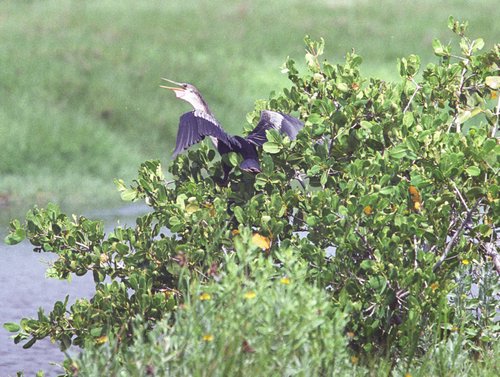
|
|
Photo by Jarrett Baker.
|
Unfortunately, we didn’t find any fossils. The millhopper is an interesting location to photograph. Its steep elevation change, waterfalls and oak trees resemble the Appalachian Mountains more than north Florida.
It can be difficult to make a photo road trip in the summer. In addition to high humidity and pesky insects, rain can reek havoc on photography equipment and camping gear.
We did not want to stay at Paynes Prairie State Park, south of Gainesville, and set our tents up in a rain shower after visiting the sink hole. We drove around the park for nearly an hour watching lightning strike and searching for photographic opportunities.
Heavy rain, gail force winds and hail pounded the Ford Expedition. If the vehicle was equipped with a Doppler radar and five different communication devices, we could have been storm chasers.
After dragging several large trees out of the roadway which were downed by lightning, we headed south.
Our search for shelter put us at the Tropical Winds Oceanfront Hotel in Daytona Beach. The night manager was a big hockey fan - he dropped $40 off the hotel cost for us because we were watching the NHL playoffs in the Lobby. For a little over $50, we managed to acquire a nice room on the fifth floor with a view of the ocean.
We headed to Hontoon Island State Park the next day. The 1,650 acre park used to be part of the mainland, but a pioneer had a channel dug to create the island. It was the closest resemblance we found to Highlands County scenery. With the exception of two large Indian mounds, the island features pine flatwoods, swamps and cypress hammocks.
The mounds were formed by Timucuan Indians thousands of years ago. A staple of their diet was snails gathered from the St. Johns River. The Indians removed the meat and tossed the shells in piles that grew to be approximately 300 feet long, 100 feet wide and 20 feet tall.
A group of Archeology and Anthropology students from the University of Florida were excavating a portion of the site. One student found an arrowhead amongst the millions of shells. Other artifacts recovered from the island and canal include a large owl totem and a rusted iron propeller.
Finding wildlife was a task at Hontoon. Armadillos can fit into holes photographers can not. We saw several wading birds across the river but our lenses were not long enough to shoot them. We compromised with nature and took scenic shots of the river and cypress trees instead.
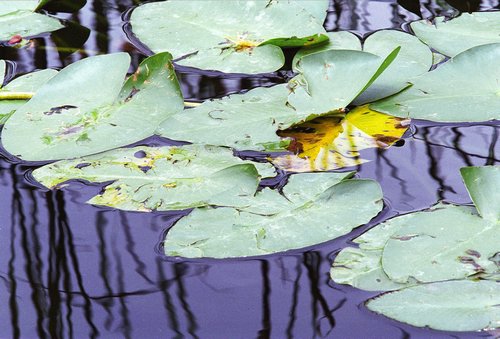
|
|
Photo by Jarrett Baker.
|
A juvenile owl was learning to fly while we attempted to sleep that night. Something was upsetting him and he made loud whining sounds for almost an hour. Clint, Tim and I could not discern what the noise was while inside our cabin.
Like other curious campers, we hopped out of bed and stared up at the tree. We tried to think of a way to send the young owl on its way. No good ideas were presented, so everyone returned to their cabins and eventually fell asleep.
Hontoon Island is only accessible by a pontoon boat that ferries guests back and forth from the parking lot to the ranger station.
“The best part of the trip (although Daytona beach had its plusses) was tromping through the halacious muck, up to my knees, in search of that one awe-inspiring bird-watchers-dream photograph at Merritt Island,” Clint Scott recently said. We left the island and spent Saturday afternoon, June 5, at Canaveral National Seashore.
Bio Lab Road offers five miles of photographic opportunities inside the preserve. The road leads off County Road 402 and joins back to County Road 3. C.R. 402 leads to Playalinda Beach while the southern portion of C.R. 3 leads into John F. Kennedy Space Center and parallels the space shuttle landing complex.
Fourteen endangered or threatened species including southern bald eagles, West Indian manatees and eastern indigo snakes are known to reside in the national seashore. While driving down Bio Lab Road, I noticed various waterfowl, including the Roseate Spoonbill, and saw countless alligators. Scientists have recorded an additional 1,045 species of plants and 310 species of birds living in the National Seashore.
We stayed at the Kampgrounds of America in Mims, about 10 miles north of Titusville. An air conditioned cabin was a welcome break from the sweltering heat of the Seashore. The accommodations were cozy, but not made for long-term stays. When I woke up on Sunday morning I hit my head on the bunk above me!
We made our second dive of the trip Sunday at Pepper Park in Ft. Pierce. The Urca de Lima was part of Spanish Merchant Convoy returning home from Cuba that ran aground in 1715 when a hurricane crossed Florida. The wreck site was designated as Florida’s first Underwater Archaeological Preserve in 1987.
Our plan was to swim from the beach to the wreck site, photograph it and head to our next photo location.
“The wreck’s about 1,000 yards north of the northern park boundary,” a lifeguard said. We were disappointed to learn how difficult it can be to access the wreck without a boat or non-existent marking flag.
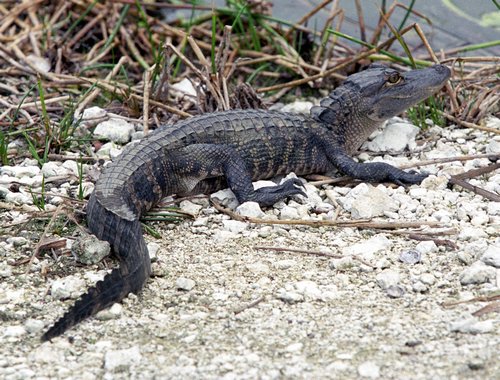
|
|
Photo by Jarrett Baker.
|
The three of us decided not to dive the wreck and photograph the small amount of hull remains still in existence. Instead, we searched for nurse sharks (and found one about eight feet long) several hundred yards off the shore of Pepper Park.
We stayed at Savannas County Park in Ft. Pierce on Sunday night. The 550 acre park is home to five biological communities including pine flatwoods, wet prairie, marsh, lake and scrub. We spent nearly two hours exploring the park before darkness enveloped the woods.
We concluded our trip with a day tour of the Everglades. We first stopped at the Micousukee Indian Reservation to buy souvenirs and speak with people that live on the reservation. Afterwards, we traveled Loop Road which juts off U.S. 41, photographing alligators and water fowl before returning to Highlands County.
“Wow! Those guys can move,” I thought whenever my movements caused alligators to dart into the murky water.
The Everglades are too large to be accurately photographed in one day or even several weeks. During the summer heat, humidity and horse flies wreak havoc on humans. “These bugs are horrible!” I remarked time and time again.
Additionally, the Tampa Bay Lightning were playing game 7 of the Stanley Cup, and we wanted to see the game.
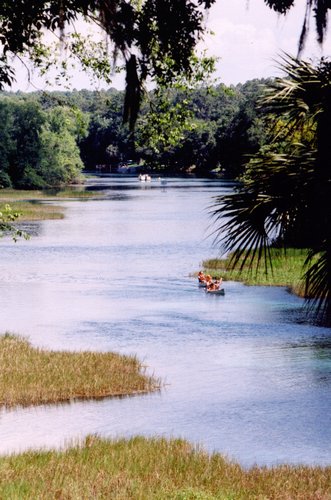
|
|
Photo by Jarrett Baker.
|
“As we entered the long stretch home, I realized the trip was coming to a close,” Clint said. “I thought to myself, We could get back in time for the hockey game!”
Florida is a land of photographic opportunities. Each season offers something slightly different, though in some places those differences might only be the amount of mosquitos and horse flies.
A photography road trip offers people the chance to spend quiet time away from the noise of every day life. In a time where Disney World attracts tourists to our towns, escaping to the wilderness might be one of the last ways we can escape the hustle and bustle of daily life.
Jarrett Baker is a columnist for DCSki. When not skiing on water or snow, Jarrett is a photographer with the Highlands County News-Sun, and a freshman at the University of Florida. You may visit Jarrett's web site here.

Join the conversation by logging in.
Don't have an account? Create one here.